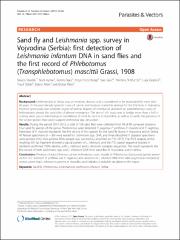| dc.contributor.author | Vaselek, Slavica | |
| dc.contributor.author | Ayhan, Nazli | |
| dc.contributor.author | Oguz, Gizem | |
| dc.contributor.author | Kasap, Ozge Erisoz | |
| dc.contributor.author | Savić, Sara | |
| dc.contributor.author | Di Muccio, Trentina | |
| dc.contributor.author | Gradoni, Luigi | |
| dc.contributor.author | Ozbel, Yusuf | |
| dc.contributor.author | Alten, Bulent | |
| dc.contributor.author | Petrić, Dušan | |
| dc.date.accessioned | 2020-04-01T17:59:43Z | |
| dc.date.available | 2020-04-01T17:59:43Z | |
| dc.date.issued | 2017 | |
| dc.identifier.issn | 1756-3305 | |
| dc.identifier.uri | https://repo.niv.ns.ac.rs/xmlui/handle/123456789/272 | |
| dc.description.abstract | Background: Leishmaniasis in Serbia was an endemic disease, and is considered to be eradicated for more than
40 years. In the past decade sporadic cases of canine leishmaniasis started to emerge for the first time in Vojvodina
Province (previously non-endemic region of Serbia). Reports of introduced, and later on autochthonous cases of
leishmaniasis alerted the possibility of disease emergence. The aim of this study was to bridge more than a half a
century wide gap in entomological surveillance of sand fly vectors in Vojvodina, as well as to verify the presence of
the vector species that could support Leishmania spp. circulation.
Results: During the period 2013–2015, a total of 136 sand flies were collected from 48 of 80 surveyed locations.
Four sand fly species of the genus Phlebotomus were detected: P. papatasi, P. perfiliewi, P. mascittii and P. neglectus.
Detection of P. mascittii represents the first record of this species for the sand fly fauna in Vojvodina and in Serbia.
All female specimens (n = 80) were tested for Leishmania spp. DNA, and three blood-fed P. papatasi specimens
were positive (4%). One positive DNA sample was successfully amplified by ITS1 nPCR. The RFLP analysis of the
resulting 350 bp fragment showed a typical pattern of L. infantum, and the ITS1 partial sequence blasted in
GenBank confirmed 100% identity with L. infantum and L. donovani complex sequences. This result represents the
first record of both Leishmania spp. and L. infantum DNA from sand flies in Vojvodina, and in Serbia.
Conclusions: Presence of autochthonous canine leishmaniasis cases, records of Phlebotomus (Larroussius) species proven
vectors of L. infantum (P. perfiliewi and P. neglectus) and detection of L. infantum DNA from wild caught (non-competent)
vectors, prove that L. infantum is present in Vojvodina and indicates a probable circulation in the region. | en_US |
| dc.description.sponsorship | The work of Slavica Vaselek, Sara Savic, Yusuf Ozbel, Bulen Alten and Dušan Petric was done under the frame of EurNegVec COST Action TD1303. | en_US |
| dc.language.iso | en | en_US |
| dc.source | Parasites and Vectors | en |
| dc.subject | Sand fly | en_US |
| dc.subject | Phlebotomus | en_US |
| dc.subject | Leishmaniasis | en_US |
| dc.subject | Leishmania infantum | en_US |
| dc.subject | Serbia | en_US |
| dc.title | Sand fly and Leishmania spp. survey in Vojvodina (Serbia): first detection of Leishmania infantum DNA in sand flies and the first record of Phlebotomus (Transphlebotomus) mascittii Grassi, 1908 | en_US |
| dc.type | Article | en_US |
| dc.identifier.doi | 10.1186/s13071-017-2386-z | |

